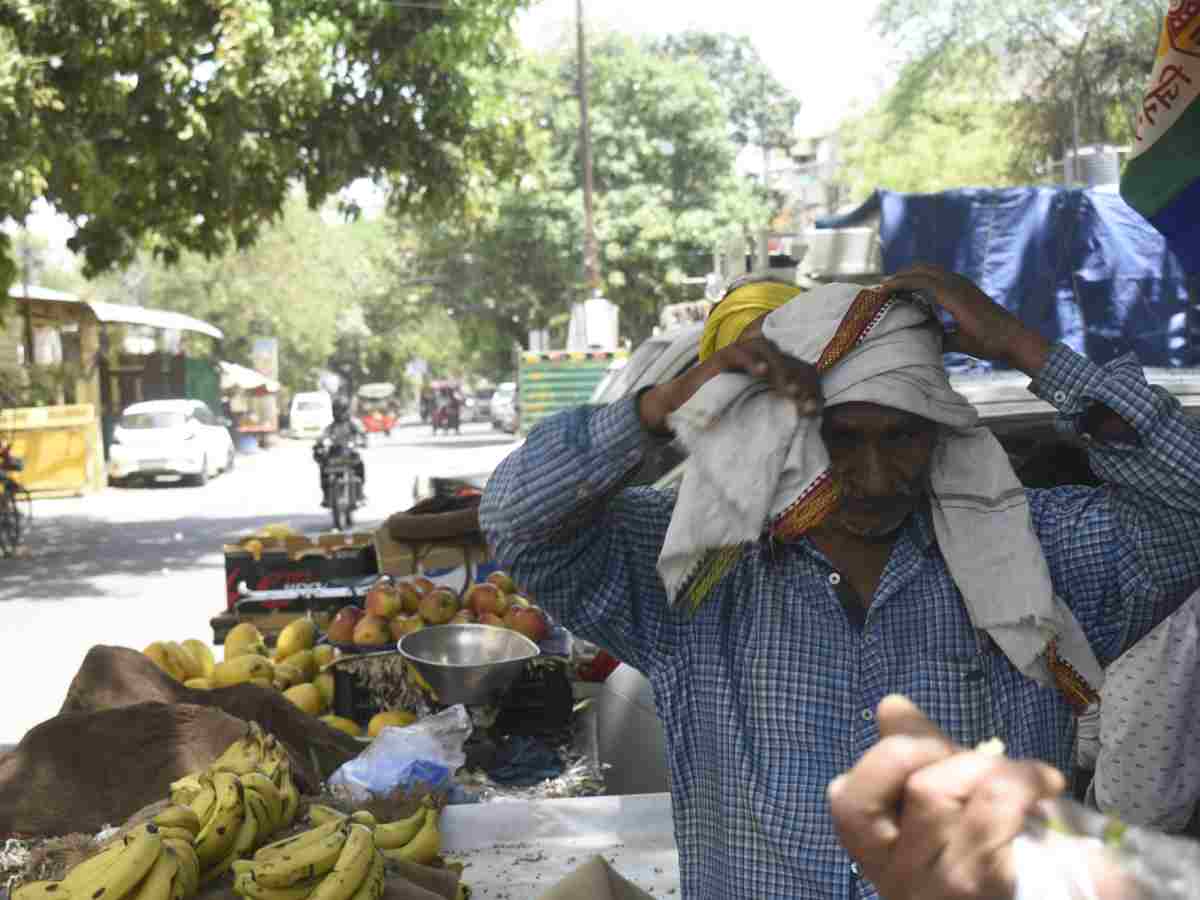
A vegetable vendor adjusts a wet cloth over his head as Delhi swelters under the scorching sun
Over 80 percent of street vendors surveyed in Delhi reported a decline in customers during heatwave days in April and May, and around 50 percent experienced significant income loss, according to a new report by Greenpeace India and the National Hawker Federation.
The study, involving 721 street vendors, was conducted in various locations including Meena Bazaar, Old Delhi Railway Station area, Red Fort area, Nehru Place, Guru Tegh Bahadur Nagar, Karol Bagh, India Gate, Janpath, Chandni Chowk, Sadar Bazar Road, Saket, and Sarojini Market.
“Data from over 700 respondents highlight the devastating impact on their health, productivity, and livelihoods. We demand immediate government intervention, including the establishment of heat shelters in markets with essential facilities, safety kits, and institutional support for the most vulnerable,” said Sandeep Verma, Convener of the National Hawker Federation Delhi.
“80.08 percent of street vendors observed a decline in customer numbers during heatwaves. 49.27 percent of them have been experiencing a loss of income due to extreme climatic conditions,” the report stated.
Many respondents experienced health issues due to the hot weather. Irritability was the most common issue, affecting 73.44 percent of respondents, followed by headaches (66.93 percent), dehydration (67.46 percent), sunburn (66.53 percent), fatigue (60.82 percent), and muscle cramps (57.37 percent).
Seven out of eight women street vendors reported experiencing high blood pressure, while women in the middle age group raised concerns about delays in their menstrual cycles due to the extreme heat.
All the women who participated in the study reported that sleeplessness during the night has become common due to increased heat, resulting in exhaustion throughout the day.
Guddi, one of the women street vendors who operates a cane crusher, said, “After being exposed to the heat of the sun all day, I don’t feel like eating dinner at night. All I can think about is stretching my legs and going to sleep.”
Seema Bhaskaran, Gender Lead at Transform Rural India, said excessive heat leads to exhaustion, dehydration, and urinary infections among women workers.
“Women working as street vendors, tea estate workers, and ‘safia sathis’ in low-paid precarious occupations are on the streets exposed to extreme heat. Their productivity is impacted, and they are exposed to illnesses. For women, sustenance tasks like fetching water, fuel wood, and fodder take longer and impact their health. Pregnant women can face issues of stillbirth and miscarriages,” she said.
The participants also flagged the issue of children in their families exhibiting symptoms like vomiting, diarrhea, and nosebleeds, further complicating the vendors’ challenges.
Over 82 percent of street vendors said they have not received any guidance on how to handle heatwaves.
The study found that a majority (71.05 percent) of street vendors struggled to get medical care due to financial constraints. Around 20 percent said they could not afford healthcare at all, and only 27 percent could afford healthcare without compromising other household necessities.
India experienced multiple intense and prolonged heatwaves in April and May, testing the limits of human endurance and the country’s disaster preparedness, with many states, including Uttar Pradesh, Bihar, and Odisha, reporting heatwave-related deaths.
According to the India Meteorological Department, 14 of the 36 sub-divisions in the country have recorded over 15 heatwave days (when the maximum temperature is at least 40 degrees Celsius and 4.5 degrees above normal) from March 1 to June 9.
Experts attribute the extreme heat to the naturally occurring El Nino phenomenon — an unusual warming of the ocean surface in the central and eastern tropical Pacific Ocean — and the rapidly increasing concentration of heat-trapping greenhouse gases in the atmosphere.
Studies show that rapid urbanization has exacerbated warming in urban areas, with outdoor workers and low-income households bearing the brunt of the impact. Low-income households have limited capacity to adapt to extreme heat because of poor access to water and electricity. The design and construction of informal houses often means there is poor ventilation and little shelter from extreme heat.
The heatwave in May saw several places across the country, including the hills of Assam, Uttarakhand, Himachal Pradesh, and Arunachal Pradesh, recording all-time high temperatures. The mercury breached 50 degrees Celsius in Rajasthan and neared this mark in Delhi and Haryana.
Similar heatwaves, which once occurred every 30 years, have become about 45 times more likely due to climate change, according to ‘World Weather Attribution’, a group of leading climate scientists. (With inputs from PTI)
Over 10 firms were found contravening provisions of the Drugs Rules, and necessary action has…
Roopchand Gajak Wale in Farash Khana is one of the oldest and most trusted names…
A Kathak evening paying tribute to composers Pandit Jwala Prasad and Pandit Madho Prasad and…
Delhi High Court upholds acquittal, says husband’s extramarital affair not linked to wife’s suicide
Key member of interstate auto-theft gang nabbed in Lakhimpur Kheri; involved in high-end car theft…
Delhi Police arrests key operator in multi-state cyber fraud cheating a senior citizen of over…